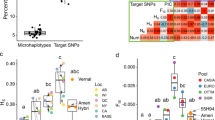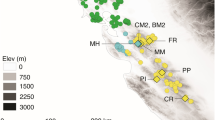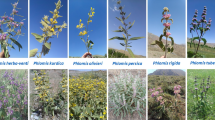Summary
Allozyme analysis, morphological characters, and histocompatibility relationships have revealed unexpected amounts of clonal diversity within and among populations of unisexual animals. Plant studies, likewise, have shown that genetic diversity exists in populations of plants that have restricted recombination. However, no work has been done which investigates the extent of genotypic diversity within and among populations of an obligate apomict.
This study surveyed 22 North American populations of Taraxacum officinale, an obligate gametophytic apomict. Over 20 individuals from each population were assayed electrophoretically for three enzyme systems representing five different migration zones. Seed colour was used to determine seven phenological classes that, when combined with the allozyme morphs, resulted in 47 discernible clones among 518 individuals sampled. Chromosome analysis revealed the ploidy level to be triploid in all cases.
The number of clones per population ranged from 1-13, with a mean of 5·0. Sixty-six per cent of the clones were restricted to single populations, and the mean number of populations containing a particular clone is 2·1. One widespread clone was found in all but three of the populations. Diversity values, expressed as clones per individual, indicate that T. officinale proved to be more genotypically diverse than other clonal plants previously studied. Spearman's Rank Correlation test failed to show a correlation of diversity with latitude or elevation.
Similar content being viewed by others
Article PDF
References
Babcock, E B, and Stebbins, G L. 1938. The American species of Crepis. Their interrelationships and distribution as affected by polyploidy and apomixis. Carnegie Inst Wash Publ No 504.
Baker, H G. 1959. Reproductive methods as factors in speciation in flowering plants. Cold Spring Harbor Symp Quant Biol, 24, 177–191.
Black, R, and Johnson, M S. 1979. Asexual vivipary and population genetics of Actinia tenebrosa. Marine Biol, 53, 27–31.
Christensen, B, Berg, M, and Jelnes, J. 1978. A comparative study on enzyme polymorphism in sympatric diploid and triploid forms of Lumbricillus lineatus (Enchytraeidae, Oligochaeta). Hereditas, 44, 169–176.
Christensen, B, Berg, M, and Jelnes, J. 1980. Recombination system and population structure in Oenothera. Evolution, 34, 923–933.
Christensen, B, Berg, M, and Jelnes, J. 1982. Genotypic diversity in Oenothera laciniata (Onagraceae), a permanent translocation heterozygote. Evolution, 36, (1), 63–69.
Ellstrand, N C, and Levin, D A. 1980. Recombination system and population structure in Oenothera. Evolution, 34, 923–933.
Ellstrand, N C, and Levin, D A. 1982. Genotypic diversity in Oenothera laciniata (Onagraceae), a permanent translocation heterozygote. Evolution, 36, 63–69.
Ford, H. 1981. Competitive relationships amongst apomictic dandelions. Biol J Linn Soc, 15, 355–368.
Fryxell, P A. 1957. Mode of reproduction in higher plants. Bot Rev, 23, 135–233.
Grant, V. 1981. Plant Speciation, 2nd ed., Columbia Univ. Press, New York.
Grant, V, and Grant, K. 1956. Genetic and taxonomic studies in Gilia. VIII. The Cobwebby Gilias. Aliso, 3, 203–287.
Gustafsson, A. 1946. Apomixis in Higher Plants. Lund, C. W. K. Glerrup.
Hancock, J F, Jr, and Wilson, R E. 1976. Biotype selection in Erigeron annuus during old field succession. Bull Torrey Bot Club, 103, 122–125.
Harberd, D J. 1961. Observations on population structure and longevity of Fustuca rubra L. New Phytol, 60, 184–206.
Harberd, D J. 1967. Observation on natural clones in Holcus mollis. New Phytol, 66, 401–408.
Heywood, J S. 1980. Genetic correlates of edaphic differentiation and endemism in Gaillardia. Ph.D. dissertation, Univ. of Texas, Austin.
Jaenike, J, Parker, E D, Jr, and Selander, R K. 1980. Clonal niche structure in the parthenogenetic earthworm Octolasian tyrtaeum. Am Natur, 116, 196–205.
Levin, D A. 1975. Genie heterozygosity and protein polymorphism among local populations of Oenothera biennis. Genetics, 79, 477–491.
Levin, D A, and Crepet, W L. 1973. Genetic variation in Lycopodium lucidulum: a phylogenetic relic. Evolution, 27, 622–632.
Levin, D A, and Kerster, H W. 1971. Neighborhood structure in plants under diverse reproductive methods. Am Natur, 105, 345–354.
Löve, A, and Löve, D. 1975. Plant Chromosomes. J. Cramer, Vaduz.
Munz, P A. 1968. A California Flora. Univ. Calif. Press, Berkeley.
Naylor, E. 1941. The proliferation of dandelions from the roots. Bull Torrey Bot Club, 68, 351–358.
Parker, E D, and Selander, R K. 1976. The organization of genetic diversity in the parthenogenetic lizard Cnemidophorus tessalatus. Genetics, 84, 791–805.
Richards, A J. 1972. The karyology of some Taraxacum species from alpine regions of Europe. Bot J Linn Soc, 65, 47–59.
Roose, M L, and Gottlieb, L D. 1976. Genetic and biochemical consequences of polyploidy in Tragopogon. Evolution, 30, 818–830.
Schultz, R J. 1977. Evolution and ecology of unisexual fishes. Evol Biol, 10, 277–331.
Sheldon, J, and Burrows, F M. 1973. The dispersal effectiveness of the achene pappus units of selected Compositae in steady winds with convection. New Phytol, 72, 665–675.
Silander, J A. 1979. Microevolution and clone structure in Spartina patens. Science, 203, 658–660.
Solbrig, O T. 1971. The population biology of dandelions. Am Sci, 59, 686–694.
Solbrig, O T, and Simpson, B B. 1974. Components of regulation of a population of dandelions in Michigan. J Ecol, 62, 473–486.
Solbrig, O T, and Simpson, B B. 1977. A garden experiment on competition between biotypes of the common dandelion (Taraxacum officinale). J Ecol, 65, 427–430.
Sorenson, T, and Gudjonsson, G. 1946. Spontaneous chromosome aberrants in apomictic Taraxaca. Kong. danske Vid. Seleske Biol Skrifte, 4, 1–48.
Steiner, E, and Levin, D A. 1977. Allozyme, SI gene, cytological and morphological polymorphism in a population of Oenothera biennis. Evolution, 31, 127–133.
Suomalainen, E, Saura, A, and Lokki, J. 1977. Evolution of parthenogenetic insects. Evol Biol, 10, 209–257.
Valentine, D, and Richards, A J. 1967. Sexuality and apomixis in Taraxacum. Nature, 214, 114.
Vrijenhoek, R C. 1978. Coexistence of clones in a heterogeneous environment. Science, 199, 549–552.
Wu, Lin, Bradshaw, A D, and Thurman, D A. 1975. The potential for evolution of heavy metal tolerance in plants. III. The rapid evolution of copper tolerance in Agrostis stolonifera. Heredity, 32(2), 165–187.
Author information
Authors and Affiliations
Rights and permissions
About this article
Cite this article
Lyman, J., Ellstrand, N. Clonal diversity in taraxacum officinale (compositae), an apomict. Heredity 53, 1–10 (1984). https://doi.org/10.1038/hdy.1984.58
Received:
Issue date:
DOI: https://doi.org/10.1038/hdy.1984.58
This article is cited by
-
Invasion success of a Lessepsian symbiont-bearing foraminifera linked to high dispersal ability, preadaptation and suppression of sexual reproduction
Scientific Reports (2023)
-
First account of vivipary in Saussurea lappa (Decne.) Sch. Bip. (Asteraceae)
Brazilian Journal of Botany (2018)
-
Hybridization rate and genotypic diversity of apomictic hybrids between native (Taraxacum japonicum) and introduced (T. officinale) dandelions in western Japan
Conservation Genetics (2018)
-
Chloroplast genome resources and molecular markers differentiate rubber dandelion species from weedy relatives
BMC Plant Biology (2017)
-
Genome size variation among common dandelion accessions informs their mode of reproduction and suggests the absence of sexual diploids in North America
Plant Systematics and Evolution (2017)



